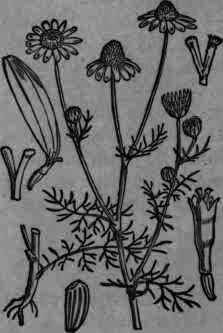Matricaria. Matricaria
Description
This section is from the book "A Manual of Materia Medica and Pharmacology", by David M. R. Culbreth. Also available from Amazon: Manual of Materia Medica and Pharmacology.
Matricaria. Matricaria
Matricaria Chamomilla,
Linni.
The dried flower-heads, with not more than 5 p. c. of stems, foreign matter.
Habitat. Europe, W. Asia, naturalized in Australia; cultivated in German settlements in the United States - common road-side weed.
Syn. Matricar., German Chamomile, Wild Chamomile, Camomile, Horsegowan, Dogs Chamovyne; Fr. Fleurs de Chamomille commune (d'Allemagne); Ger. Flores Chainomillae, Kamillen.
Mat-ri-ca'ri-a. L. fr. matrix, matrice, the womb - i. e., its supposed effect on that organ; name used by the medieval pharmacists.
Cham-o-miria, better Camomilla. L. fr. Gr.
on the earth, +
an apple, lit. "earth apple" - i. e., from odor of the bruised plant and flowers (Dios-curides).
Plant. - Annual herb; stem .3-.6 M. (1-2°) high, branched, smooth, solid, striate, pale green; leaves 5 Cm. (2') long, lower tripinnate, upper bipinnate, green, smooth; leaflets linear, small. Flowers, May-Aug., composed of a few white ray-florets and numerous yellow disk-florets on a conical hollow receptacle, 3-10 Mm. (1/8-2/5') broad; disk-florets tubular, perfect, without pappus; ray-florets 10-20, pistillate, corolla white, 3-toothed, 4-veined, usually reflexed; involucre hemispherical, composed of 20-30 imbricated, oblanceolate, pubescent scales; peduncles greenish, longitudinally furrowed, somewhat twisted, 2.5 Cm. (1') long; achenes obovoid, faintly 3-5-ribbed; pappus none, or only slight membranous crown; odor pleasant, aromatic; taste aromatic, bitter. Should be kept in tightly-closed containers and guarded against insect attack. Solvents: boiling water; alcohol. Dose, gr. 15-60 (1-4 Gm.).
Adulterations. - Anthemis arvensis and A. (Maruta) Cotula have very similar flower-heads, but receptacles conical, solid, chaffy; also Santolina species.
Constituents. - Volatile oil .25 p. c, Anthemic acid, anthemidin (tasteless, crystalline), extractive, tannin, malates, ash 13 p. c.
Volatile Oil. - Obtained by distilling entire plant or flowers; dark blue liquid, due to azulene, sp. gr. 0.940, soluble in alcohol; consists of a paraffin-like body, terpene, C10H16, and a colorless oil, anthemol,
C10H16O. An artificial oil is used in Germany (flowers (480) + oil of lemon (1), distilled with water); it is deep blue, more limpid, and changes color easier than the pure oil. Dose, ej-5 (.06-.3 Ml. (Cc.)), on sugar, in pill or ether.
Preparations. - (Unoff.): Infusion, 5 p. c, when cold a tonic, when warm an emetic. Dose, ad libitum. Oleum Chamo-milloe Infusum (flowers (10), olive oil (100), digested 2 hours). Used externally. Syrup (flowers 3 parts, water for infusion 10, + sugar 18). Poultice.
Properties. - Stimulant (volatile oil), tonic (anthemic acid), carminative, diaphoretic, nervine, emmenagogue, antispasmodic, anthelmintic, less agreeable than An-themis nobilis, but may be substituted for it. Uses. - Warmth to stomach, to aid digestion in convalescence, general debility, inter-mittents, delirium tremens, flatulent colic; externally - local pains, intestinal and uterine colic, toothache, earache, abscesses, sprains, rheumatism.

Fig. 421. - Matricaria Chamo-milla.

Fig. 422. - Matricaria: a, flower-head; b, involucre; c, receptacle and involucre; d, longitudinal section of receptacle, with disk-florets; e, ray-floret; f, disk-floret; g, stamens and style of disk-floret.
Continue to:


